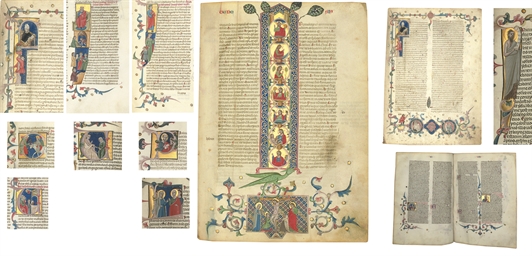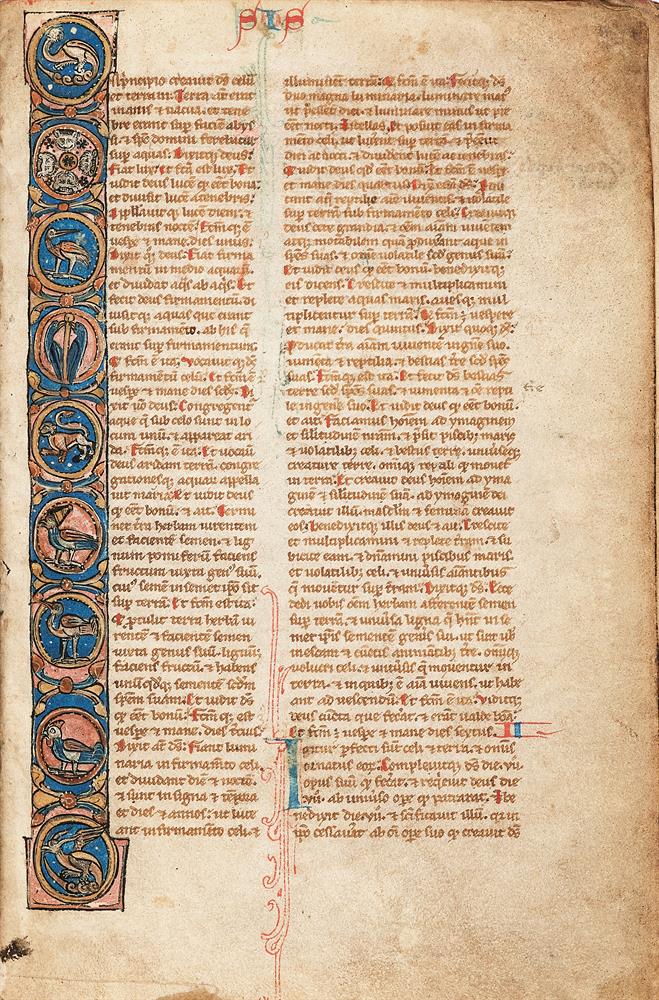HEBREW MANUSCRIPT]. BIBLE, in Hebrew. - PENTATEUCH. SEPHARDIC TORAH SCROLL ON BROWN VELLUM. [Spain, second half of the 14th century] COMPLETE. Length of the entire scroll: 50 m.; height: 61 cm. (which is approximately the circumference of the scroll when it is rolled tightly, cf. Maimonides, Mishneh Torah, Laws of the Torah Scroll , 9:1; when it is rolled loosely the circumference is more than 70 cm). Written on brown vellum (so-called gevil, i.e., skins that were processed for writing on one side only), coated with a dark brown varnish, which is typical of Spanish Torah scrolls. 67 sheets, widths varying from 56 to 91 cm, with 3-5 text columns per sheet (the last sheet 2 columns), 42 lines of text per column. Column width: 14-16 cm; Song of the Sea (Ex. 15): 27 cm; Song of Ha'azinu (Deut. 32): 22.5 cm. Upper margin: 7 cm; lower margin: 11 cm. Probably copied by two scribes. (Occasional light spots representing erasures with corrected text clearly written over, occasional defects in sewing between membranes sometimes repaired by vellum patches on verso, occasional tears and minor fraying to blank margins, one tiny wormhole through each column of the first ten membranes.) The Hebrew Pentateuch survives in two formats, the scroll (which is the oldest and longest lasting) and the codex, either separately or as part of a manuscript Bible. It was in the form of the scroll that it was used in the ancient world and in which it still survives in modern Judaism. Insofar as there are any truly sacred objects in Judaism, the Torah scroll is by far the holiest and most important item. From Talmudic times there have been precise rules for the preparation of the skin for Torah scrolls and for the copying of the text. It is regarded as a Biblical commandment for every Jew to write a Torah scroll. The Scroll of the Law, handwritten on parchment and containing the Hebrew text of the Five Books of Moses without vowels or accents, is used mainly for public reading during synagogue services. This public reading of the Five Books of the Torah (Pentateuch) is usually completed in a yearly cycle. The Torah is divided into 54 portions, which are read in synagogue one or, occasionally, two each week, on Mondays, Thursdays, Sabbath and festivals. The Torah is cantillated in a specific way, which differs between the Ashkenazic and the Sephardic communities. Public reading is only allowed from a kosher scroll (i.e., one that is fit for use). A scroll is already unfit for use if only one letter has been omitted, or the ink slightly faded. Because of the constant use of Torah scrolls for public reading, they tended to become worn and were invalidated for use relatively soon. Consequently they were stowed away in a Genizah (a storage for worn holy books) or buried and not meant to be preserved. The primary source of information on the actual writing of Torah scrolls is a minor tractate of the Talmud, entitled Massekhet Soferim . It lays down all the basic rules and may as such be considered a handbook for scribes. Many regulations, however, were discussed in great detail in later works as well, both in general halakhic compendia (such as Moses Maimonides' Mishneh Torah ) and in monographic works devoted entirely to the writing of Torah scrolls. The present Spanish scroll is EXTREMELY IMPORTANT AND OF UTMOST RARITY, in that it features a number of scribal peculiarities that, on the one hand, are known from medieval writings, but, on the other hand, were until now never attested in any medieval scroll from Spain. Only three scrolls from medieval Spain are known to exist today, a scroll that Nissim of Gerona wrote for himself, a scroll that was preserved in Rhodes -- both now in the Jewish National and University Library in Jerusalem -- and the one offered for sale here, which is in an excellent state of preservation and is THE ONLY SURVIVING TORAH SCROLL FROM SPAIN CONTAINING 'SPIRAL AND CURVED LETTERS', as advocated by Moses Maimonides. The dating and l
HEBREW MANUSCRIPT]. BIBLE, in Hebrew. - PENTATEUCH. SEPHARDIC TORAH SCROLL ON BROWN VELLUM. [Spain, second half of the 14th century] COMPLETE. Length of the entire scroll: 50 m.; height: 61 cm. (which is approximately the circumference of the scroll when it is rolled tightly, cf. Maimonides, Mishneh Torah, Laws of the Torah Scroll , 9:1; when it is rolled loosely the circumference is more than 70 cm). Written on brown vellum (so-called gevil, i.e., skins that were processed for writing on one side only), coated with a dark brown varnish, which is typical of Spanish Torah scrolls. 67 sheets, widths varying from 56 to 91 cm, with 3-5 text columns per sheet (the last sheet 2 columns), 42 lines of text per column. Column width: 14-16 cm; Song of the Sea (Ex. 15): 27 cm; Song of Ha'azinu (Deut. 32): 22.5 cm. Upper margin: 7 cm; lower margin: 11 cm. Probably copied by two scribes. (Occasional light spots representing erasures with corrected text clearly written over, occasional defects in sewing between membranes sometimes repaired by vellum patches on verso, occasional tears and minor fraying to blank margins, one tiny wormhole through each column of the first ten membranes.) The Hebrew Pentateuch survives in two formats, the scroll (which is the oldest and longest lasting) and the codex, either separately or as part of a manuscript Bible. It was in the form of the scroll that it was used in the ancient world and in which it still survives in modern Judaism. Insofar as there are any truly sacred objects in Judaism, the Torah scroll is by far the holiest and most important item. From Talmudic times there have been precise rules for the preparation of the skin for Torah scrolls and for the copying of the text. It is regarded as a Biblical commandment for every Jew to write a Torah scroll. The Scroll of the Law, handwritten on parchment and containing the Hebrew text of the Five Books of Moses without vowels or accents, is used mainly for public reading during synagogue services. This public reading of the Five Books of the Torah (Pentateuch) is usually completed in a yearly cycle. The Torah is divided into 54 portions, which are read in synagogue one or, occasionally, two each week, on Mondays, Thursdays, Sabbath and festivals. The Torah is cantillated in a specific way, which differs between the Ashkenazic and the Sephardic communities. Public reading is only allowed from a kosher scroll (i.e., one that is fit for use). A scroll is already unfit for use if only one letter has been omitted, or the ink slightly faded. Because of the constant use of Torah scrolls for public reading, they tended to become worn and were invalidated for use relatively soon. Consequently they were stowed away in a Genizah (a storage for worn holy books) or buried and not meant to be preserved. The primary source of information on the actual writing of Torah scrolls is a minor tractate of the Talmud, entitled Massekhet Soferim . It lays down all the basic rules and may as such be considered a handbook for scribes. Many regulations, however, were discussed in great detail in later works as well, both in general halakhic compendia (such as Moses Maimonides' Mishneh Torah ) and in monographic works devoted entirely to the writing of Torah scrolls. The present Spanish scroll is EXTREMELY IMPORTANT AND OF UTMOST RARITY, in that it features a number of scribal peculiarities that, on the one hand, are known from medieval writings, but, on the other hand, were until now never attested in any medieval scroll from Spain. Only three scrolls from medieval Spain are known to exist today, a scroll that Nissim of Gerona wrote for himself, a scroll that was preserved in Rhodes -- both now in the Jewish National and University Library in Jerusalem -- and the one offered for sale here, which is in an excellent state of preservation and is THE ONLY SURVIVING TORAH SCROLL FROM SPAIN CONTAINING 'SPIRAL AND CURVED LETTERS', as advocated by Moses Maimonides. The dating and l
.jpg?w=400)


.jpg)










Testen Sie LotSearch und seine Premium-Features 7 Tage - ohne Kosten!
Lassen Sie sich automatisch über neue Objekte in kommenden Auktionen benachrichtigen.
Suchauftrag anlegen